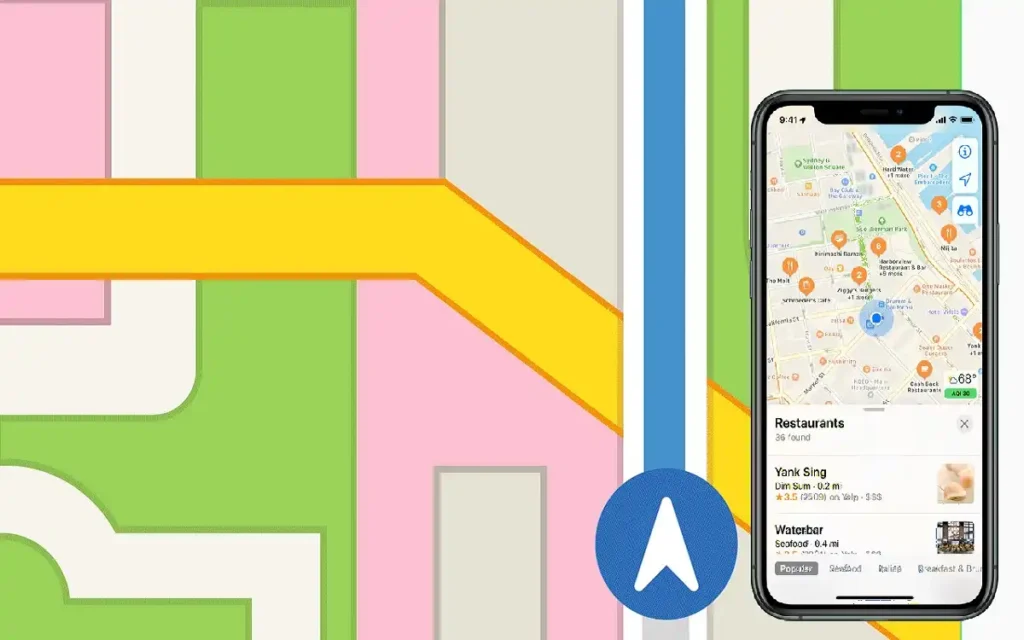Introduction
Apple has unveiled a public beta of Apple Maps for the web. This strategic expansion allows users worldwide to access Apple’s robust mapping platform directly from their web browsers, marking a significant milestone in the company’s ongoing efforts to compete with industry giants like Google Maps.
The launch of Apple Maps on the web is not just another feature update; it’s a bold statement of intent. By making its mapping service accessible beyond the confines of Apple devices, the tech giant is throwing down the gauntlet in the fiercely competitive world of digital cartography. This move not only broadens Apple’s user base but also promises to enhance the overall user experience for millions of people seeking reliable navigation and location-based services.
Recent Released: Apple Celebrate National Parks Activity Challenge August
Join us on this journey as we map out the future of web-based navigation with Apple at the helm.
Unpack Apple Maps for Web: A Feature-Rich Experience

Navigating with Ease
At the heart of Apple Maps for web lies its core functionality: providing users with accurate and efficient navigation. The platform offers:
- Driving Directions: Whether you’re planning a cross-country road trip or just trying to find the quickest route to your local grocery store, Apple Maps has you covered. The service provides turn-by-turn driving directions, factoring in real-time traffic conditions to ensure you reach your destination as quickly as possible.
- Walking Directions: For those who prefer to explore on foot, Apple Maps offers detailed walking directions. This feature is particularly useful for urban dwellers and tourists alike, helping them navigate city streets and discover hidden gems along the way.
Discovering Places of Interest
Apple Maps for web goes beyond simple navigation, offering a rich database of places and points of interest:
- Comprehensive Place Information: Each location on the map comes with a detailed place card, providing users with a wealth of information. This includes:
- High-quality photos of the location
- Operating hours
- User ratings and reviews
- Contact information
- Interactive Features: Users can take direct actions from the place cards, such as:
- Making restaurant reservations
- Ordering food for delivery or pickup
- Booking appointments
- Curated Guides: One of the standout features of Apple Maps for web is its collection of curated Guides. These Guides offer expert recommendations for:
- Restaurants and cafes
- Shopping destinations
- Cultural attractions and landmarks
- Hidden gems and local favorites
These Guides cover cities worldwide, making them an invaluable resource for both locals and travelers looking to explore new destinations.
Future Enhancements
While the current iteration of Apple Maps for web already offers a robust set of features, Apple has promised even more exciting additions in the coming months:
- Look Around: This immersive feature, similar to Google’s Street View, will allow users to explore street-level imagery of various locations. It promises to offer a more interactive and visually engaging way to preview destinations before visiting them in person.
- Additional Languages: Currently available in English, Apple plans to expand support for multiple languages, making the service accessible to a truly global audience.
- Browser Compatibility: As the platform matures, expect to see support for a wider range of web browsers across different operating systems.
Platform Support: Bridging the Gap
One of the most significant aspects of Apple Maps’ web launch is its cross-platform availability. This move represents a departure from Apple’s traditionally closed ecosystem approach, signaling a new era of accessibility for the company’s services.
Current Supported Platforms
| Platform | Supported Browsers |
| Mac | Safari, Chrome |
| iPad | Safari, Chrome |
| Windows | Chrome, Edge |
This initial rollout ensures that a significant portion of internet users can access Apple Maps regardless of their device or operating system preferences. However, it’s worth noting that this is just the beginning.
Future Expansion Plans
Apple has made it clear that they intend to broaden the reach of Apple Maps for web even further. Users can look forward to:
- Additional Browser Support: Expect to see compatibility with more web browsers in the future, potentially including Firefox and others.
- Mobile Web Support: While the current version focuses on desktop and iPad browsers, future updates may bring full functionality to mobile web browsers on smartphones.
- Linux Compatibility: As Apple continues to expand its web presence, support for Linux operating systems could be on the horizon.
This commitment to platform expansion underscores Apple’s determination to make Maps a universally accessible service, challenging the dominance of competitors like Google Maps in the web mapping space.
Empower Apple Map Developers: MapKit JS and Beyond
The launch of Apple Maps for web isn’t just a boon for end-users; it also opens up exciting new possibilities for developers. Apple is providing robust tools and support to ensure that developers can seamlessly integrate Apple Maps into their web applications and services.
MapKit JS: Bringing Apple Maps to Any Website
At the forefront of Apple’s developer offerings is MapKit JS, a powerful JavaScript library that allows developers to embed interactive Apple Maps into their websites. This tool provides several key advantages:
- Cross-Platform Compatibility: MapKit JS works across various platforms and operating systems, ensuring a consistent mapping experience regardless of the user’s device.
- Rich Feature Set: Developers can access many of the same features available in the native Apple Maps app, including:
- Custom annotations and overlays
- Geocoding and reverse geocoding
- Directions and route planning
- Customization Options: MapKit JS offers extensive customization capabilities, allowing developers to tailor the look and feel of embedded maps to match their website’s aesthetics.
- Performance Optimization: Built with efficiency in mind, MapKit JS ensures smooth performance even on websites with high traffic volumes.
Seamless Integration with Apple Maps for Web
With the launch of Apple Maps on the web, developers now have even more flexibility in how they integrate mapping services into their projects:
- Direct Linking: Developers can now link out to Apple Maps on the web, allowing users to access full mapping functionality without leaving the context of the original website.
- Enhanced Place Information: By leveraging the rich data available in Apple Maps, developers can provide users with detailed place information, including photos, reviews, and operating hours.
- Action Integration: Users can perform actions like getting directions or ordering food directly from place cards, creating a more seamless and interactive experience.
The Future of Web Mapping Development
As Apple continues to refine and expand its web mapping offerings, developers can look forward to:
- New APIs and SDKs: Expect Apple to release additional tools and frameworks to further enhance web mapping capabilities.
- Improved Documentation and Support: As the platform grows, Apple is likely to provide more comprehensive documentation and developer resources.
- Integration with Other Apple Services: Future updates may allow for tighter integration between Apple Maps and other Apple web services, creating new opportunities for innovative web applications.
The Competitive Landscape: Challenging Google’s Dominance
The launch of Apple Maps on the web represents a significant shift in the digital mapping ecosystem. For years, Google Maps has been the de facto choice for web-based mapping services, but Apple’s entry into this space is set to shake things up.
Comparative Advantages
While Google Maps still holds a significant lead in terms of user base and data accuracy, Apple Maps for web brings several unique advantages to the table:
- Privacy Focus: In line with Apple’s commitment to user privacy, Apple Maps offers robust location services without compromising personal data.
- Seamless Apple Ecosystem Integration: For users already invested in the Apple ecosystem, the web version of Apple Maps provides a familiar and consistent experience across devices.
- Aesthetic Appeal: Apple’s design prowess shines through in its mapping service, offering a visually pleasing and intuitive user interface.
- Curated Content: The inclusion of expert-curated Guides sets Apple Maps apart, offering a more personalized and locally-focused exploration experience.
Potential Impact on the Market
The introduction of Apple Maps to the web is likely to have several far-reaching effects:
- Increased Competition: With a major player like Apple entering the web mapping arena, we can expect to see accelerated innovation and feature development across all mapping platforms.
- Shift in User Behavior: As Apple Maps becomes more accessible, we may see a gradual shift in user preferences, particularly among Apple device users who can now enjoy a consistent mapping experience across all their devices and the web.
- Developer Adoption: The availability of MapKit JS and direct integration with Apple Maps on the web may encourage more developers to incorporate Apple’s mapping services into their projects, further expanding the platform’s reach.
- Data Improvement: As more users engage with Apple Maps on the web, the increased data flow is likely to contribute to improved accuracy and more up-to-date information across the platform.
Finally Charting the Future of Web-Based Navigation
The launch of Apple Maps on the web marks a significant milestone in the evolution of digital cartography. By breaking free from the constraints of its own ecosystem, Apple is not only expanding its user base but also setting the stage for a new era of competition and innovation in the mapping industry.
For users, this development promises a richer, more diverse set of options for their navigation and location-based needs. The integration of features like curated Guides and seamless action execution directly from place cards hints at a future where maps are not just tools for getting from point A to point B, but comprehensive platforms for exploring and interacting with the world around us.
Developers, too, stand to benefit greatly from this expansion. With tools like MapKit JS and the ability to integrate directly with Apple Maps on the web, the potential for creating innovative, map-centric web applications has never been greater.
While it remains to be seen how this will ultimately reshape the competitive landscape, one thing is certain: the world of digital mapping is evolving, and users around the globe stand to benefit from the increased choice, innovation, and functionality that this evolution brings.
As Apple Maps charts its course through the vast expanse of the world wide web, it invites us all to explore, discover, and navigate in new and exciting ways. The journey has just begun, and the destination promises to be nothing short of revolutionary.






